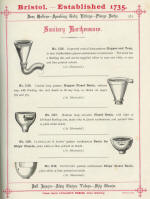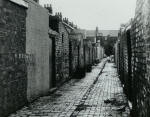 |
Victorian & Edwardian Services (Houses) 1850-1914 |
  |
|
|
3 1850s - Working Class
 |
The services of a working class terraced house in the 1850s were simple in
the extreme although our knowledge of the detailed arrangements of humble urban
dwellings of this period remains scanty. Few families had their own water supply
and had to rely on a communal pump in the street. Sanitary arrangements were
also basic with many houses having a privy contained in a small structure behind
the kitchen in the back yard. The privy consisted of nothing more than a fixed
wooden seat with a round hole over a large void which connected to a brick lined
cesspool via a short inclined drain. The cesspools were often shared between two
or more houses and lacking adequate water and poorly maintained, they often
became blocked and overflowed leading to stagnant pools of foul water
accumulating in back yards and alleys. As a result, outbreaks of diseases such
as smallpox, typhus and cholera were common. Some houses were supplied with WCs
of the cheap hopper or cottage type but as the water level in these was confined
to the trap below the basin they were inclined to accumulate solid matter;
moreover, a source of flush water was often lacking altogether. Many ended up in
a filthy state which only confirmed the views of many educated Victorians that
the working classes were incapable of managing their own sanitary arrangements! |
 |
In the industrial suburbs of most northern industrial towns the water closet
was virtually unknown and dry privies, which relied upon household ash to
deodorise human excrement, were widely used instead. They were located in the
small out-houses and the rows of these small structures was a common sight,
across the north, lining the back alley ways in-between the rows of terraced
houses. Where back-to-back houses were common, as in the mill towns of West
Yorkshire, the closets were arranged in blocks at the ends of the terrace. |
| The typical plan of the industrial small town house was the ‘two up two down’
- just two main rooms on the ground floor - and two bedrooms above separated by
the staircase. A small kitchen or scullery was located in a small single storey
extension projecting into the back yard. A fireplace flanked by a wash copper
and stone sink were usually built into the rear wall of the kitchen which is why
these extensions almost invariably had a separate chimney stack from the main
part of the house. Prince Albert encouraged the use of kitchen ranges in his
model labourers’ cottages built in South Kensington for the Great Exhibition in
1851 but it is clear that most mid-Victorian working class kitchens had no
cooking facility other than a simple open grate of iron bars set between masonry
hobs. Information on the extent of gas lighting in new working class homes in
the mid-century is almost entirely lacking but it is likely there was little or
none. When the Industrial Dwellings Company built some working class tenements
in Jacobs Wells in Bristol in 1875, gas lighting was laid on in the stairways
and shared balconies but not in the rooms. |
|
|